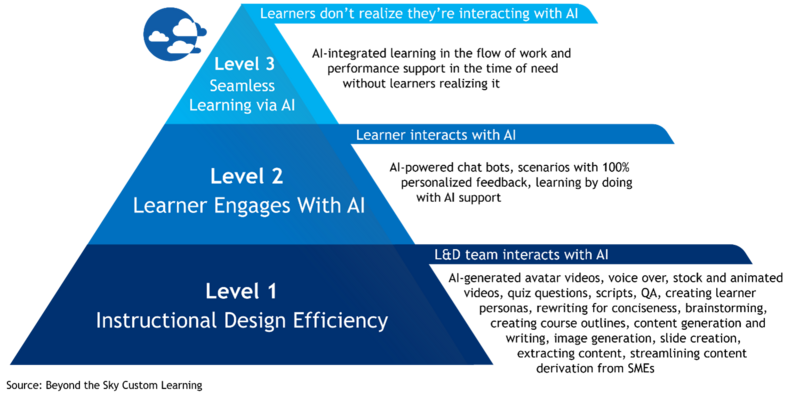ATD Blog
3 Levels of AI Integration: From Speeding Up Workflows to Scaling New Heights
Fri Mar 08 2024

Are you already trying to use artificial intelligence (AI) to streamline your processes in talent development, or are you on the cusp of discovering how it can transform the way you develop workplace capabilities on a grand scale? The L&D movement into AI is not just a step but a giant leap forward in how we cultivate skills and knowledge.
It’s clear that the potential applications of AI in talent development are both broadly and deeply transformative. However, it’s equally evident, through the collective wisdom I’ve gained from the AI + L&D Community of Practice, that the journey toward fully leveraging AI in L&D is marked by a mix of enthusiasm for innovation and caution.
To navigate the complexities of integrating AI into L&D, it’s useful to think about the process as occurring across three distinct levels of AI sophistication and impact. This framework not only helps in understanding the current landscape but also in identifying the opportunities and challenges at each stage.
Figure 1: The Three Levels of AI Integration

Level 1: Enhancing Instructional Design Efficiency With AI
Level 1 involves using AI to streamline the instructional design process, making it more efficient and effective. AI tools can automate routine tasks, such as generating videos, creating voiceovers, creating knowledge check questions, summarizing subject matter expert (SME) conversations, creating course objectives and outlines, and more. At this level, it’s the L&D teams that are using AI, and they’re using AI to speed up the work they are currently doing. This is the easiest way organizations can use AI, and there are myriad AI tools for L&D.
However, I foresee a risk at this level: the potential misuse of level 1 AI tools by SMEs to create ineffective training. I’ve spoke with many non-L&D leaders who are excited about the ability to quickly create “training.” For instance, these SMEs might rely on AI to generate instructor-led training slides from a prompt or to produce lengthy AI avatar videos.
Without the right skills in instructional design or help from an L&D team, the misapplication of these AI-powered “training creation” tools can lead to materials that are not effective. Not only could they be misaligned with the performance objectives, but they could squander valuable employee time on training that simply doesn’t deliver results. That’s why L&D’s role is important—by using proven instructional methods, we can create learning solutions that improve performance. Hence, it’s important that we master level 1 L&D tools before our non-L&D counterparts employ them without us.
Level 2: Enabling Learners to Interact With AI for Learning at Scale
In contrast, level 2 is only within L&D’s domain to operationalize. The second level of AI in L&D represents a significant leap forward, focusing on direct learner interaction with AI to enable learning experiences that are not possible with today’s tools. Instead of course creators interacting with AI, learners interact directly with AI.
This is where AI’s potential to personalize learning comes to the forefront, offering scalable solutions that can adapt to the needs of each learner. Examples include AI-powered chatbots that provide real-time support and feedback, ChatGPT and e-learning interactions that allow for 100 percent customized feedback on role plays, personalized coaching that’s always available, and more.
The innovation at this level lies in AI’s ability to create better and more effective talent development solutions. Traditional tools are limited in their capacity to adapt to individual learners’ needs, often providing a one-size-fits-all approach that fails to engage or challenge learners effectively, such as e-learning scenarios with pre-set multiple choice paths. However, AI can analyze what a learner inputs to offer customized feedback, suggest relevant resources, and even create learning scenarios that are directly applicable to the learner’s context. I’ve seen the benefits of our AI-powered e-learning at scale. This approach not only enhances the learning experience but also ensures that learners can apply their knowledge more effectively in real-world situations.
Level 3: Achieving Seamless Integration of AI Into Learning
The pinnacle of AI integration in L&D is achieved when AI is so seamlessly woven into the learning experience that its presence is virtually unnoticed by learners. At this level, AI becomes an integral part of the workflow, providing just-in-time support and guidance that enhances performance without interrupting the natural flow of work.
Examples include learning in the flow of work, which could be via digital adoption platforms that are truly easy to use and implement so they can offer widespread assistance without the employee even noticing. This seamless integration into technology makes learning and support omnipresent, enabling employees to excel in their roles. Other forward-thinking examples feature personal assistants at work that anticipate and fulfill your needs before you even articulate them. Or AI-powered coaches that offer timely guidance just when you’re about to need it, embodying the pinnacle of proactive support in the workplace.
The seamless integration of AI at this stage signifies a mature application of technology where learning and work are not distinct entities but are interwoven in a way that facilitates continuous improvement and skill development.
The challenge at this level is not just technical integration but also ensuring that the AI-powered learning experiences are intuitive, relevant, and aligned with the learner’s immediate needs. Success here depends on the ability of L&D professionals to design AI systems that are not only sophisticated but also user friendly and deeply embedded in the organizational culture.
Conclusion
The evolution of AI in L&D, from enhancing instructional design to enabling personalized learning at scale, and, finally, to achieving seamless integration, represents a transformative journey. Each level brings its own set of opportunities and challenges, from the risk of creating ineffective courses at level 1 to the technical and design complexities at level 3.
As L&D professionals exploring the potential of AI, our focus should be on leveraging its capabilities to create more adaptive, engaging, and effective learning experiences. This journey requires a thoughtful approach, balancing the innovative potential of AI with the practical realities of implementing technology in various learning environments. By advancing through these levels of AI integration, we can pave the way for a future where learning is not just about content consumption but about engaging with knowledge in a dynamic, personalized, and effective way.
